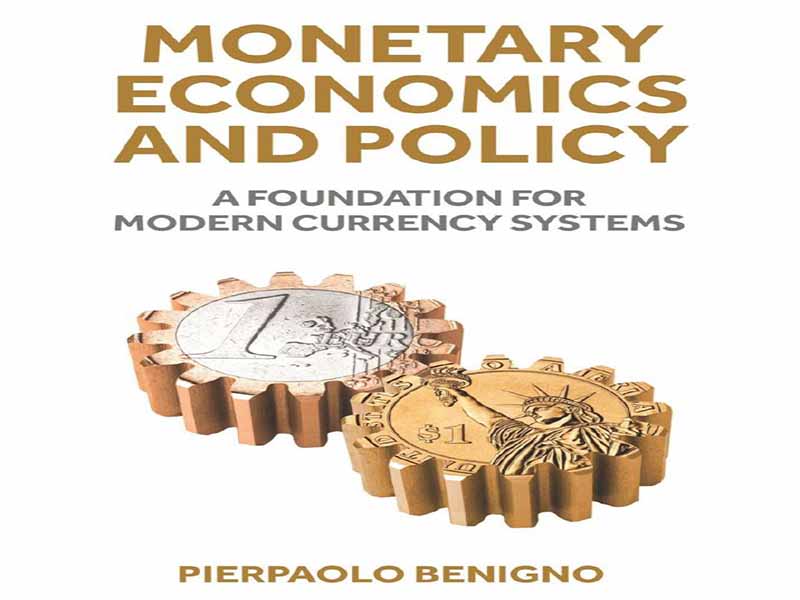- عنوان کتاب: Monetary Economics and Policy -A Foundation for Modern Currency Systems
- نویسنده: Pierpaolo Benigno
- حوزه: پولی
- سال انتشار: 2025
- تعداد صفحه: 428
- زبان اصلی: انگلیسی
- نوع فایل: pdf
- حجم فایل: 5.39 مگابایت
کتاب زیر برگرفته از مجموعهای از سخنرانیهای ارائه شده در دوره بهار ۲۰۲۰ اقتصاد پولی در دانشگاه برن است، جایی که من در ژانویه ۲۰۲۰ سمت استادی اقتصاد کلان پولی را بر عهده گرفتم. برخی از سخنرانیها حضوری و برخی دیگر به دلیل اقدامات قرنطینهای مربوط به بیماری همهگیر کووید-۱۹ به صورت آنلاین برگزار شد. قرنطینه زمان کافی را برای من فراهم کرد تا فرآیند تهیه پیشنویس را آغاز کنم و مطالب را به صورت اولیه منتشر کنم. اگرچه تلاش اولیه در زمینههای مختلف با شکست مواجه شد، اما من در طول سالها به طور مداوم مطالب را اصلاح کردهام، محتوای اضافی را گنجاندهام و موضوعات جدید را بررسی کردهام و در عین حال درک خود را از اقتصاد پولی عمیقتر کردهام. اصلاح مداوم این پروژه، آن را به یک کار بلندپروازانهتر تبدیل کرده است. اکنون به بررسی جنجالهای نظری و سیاستی فعلی میپردازد و با مسائل مشابهی که در تاریخ اقتصاد پولی نفوذ کردهاند، ارتباط برقرار میکند. هدف کلی ارائه یک چارچوب جامع و یکپارچه برای درک اقتصاد و سیاست پولی، روشن کردن این جنجالها یا حداقل ارائه دیدگاهی کامل در مورد آنها است. در هسته این چارچوب، مدلهای پولی خرد قرار دارند که در آنها ارز ذاتاً بیارزش تلقی میشود. ارزی که فاقد ارزش ذاتی است، مانند ارز دولتی امروزی یا ارزهای دیجیتال، مفهومی نسبتاً جدید در تاریخ است، کاملاً مرموز، که از زمان کنار گذاشته شدن سیستم برتون وودز در سال ۱۹۷۳ به طور برجستهای در حال ظهور است. با این حال، تعریف دقیقی دارد: ادعایی که وعده پرداخت به واحدهای خود را میدهد. این تعریف به صادرکننده ارز این قدرت را میدهد که این ادعاها را به دلخواه و فارغ از وابستگی به یک کالای ملموس چاپ کند. فعالیتهای پولی در طول پانزده سال گذشته، که با رویدادهای خارقالعادهای مانند بحران مالی ۲۰۰۷-۲۰۰۸، قرنطینه جهانی کووید-۱۹ و موج تورمی اخیر مشخص شدهاند، گواهی بر قدرتی هستند که بانکهای مرکزی در اقتصاد دارند. ما شاهد بودهایم که آنها چقدر خلاقانه ابزارها و «سلاحهای» نادیده خود را به کار گرفتهاند. بخش اول این کتاب به یک موضوع جذاب در اقتصاد پولی میپردازد که برای پیشبرد درک ما از اثربخشی سیاست پولی ضروری است. موضوع اصلی حول محور کنترل سطح قیمتها میچرخد و بررسی میکند که آیا بانک مرکزی میتواند ارزش ارز را در مسیر دلخواه تثبیت کند یا خیر. ارزی که فاقد ارزش ذاتی است، در جستجوی پشتوانه واقعی است، اما تعریف ارز، با دادن ویژگیهای خاص به بدهیهای بانک مرکزی، تنها میتواند بانک مرکزی را به عنوان عاملی که میتواند ارزش آن را به طور کامل کنترل کند، توانمند سازد. این بخش، طیف متنوعی از ابزارهای موجود برای بانک مرکزی را برای این منظور به نمایش میگذارد. در چارچوب کلی پیشنهادی برای تعیین قیمت، نظریههای بحثبرانگیزی مانند «نظریه مالی سطح قیمت» گنجانده شدهاند، به ویژه به عنوان یک مورد خاص که بانک مرکزی با پشتوانه بدهی خزانه، ویژگیهای منحصر به فرد بدهیهای خود را به خزانهداری گسترش میدهد. بخش اول همچنین مفهوم پول را، به ویژه در یک سیستم پول کاغذی مرتبط، بررسی میکند. این مفهوم فراتر از ارز (پول پایه) صادر شده توسط بانک مرکزی است و مطالبات مالی خصوصی، که به عنوان داراییهای امن شناخته میشوند، را در بر میگیرد. این داراییها ویژگیهای مشابهی با ارز دارند و به عنوان ذخیره ارزش و واسطه مبادله عمل میکنند. این دیدگاه گسترده، تحلیلی از جنجالهای گذشته در مورد عرضه نقدینگی را مطرح میکند و این سوال را مطرح میکند که آیا باید توسط بخش خصوصی یا دولت و به چه روشی تأمین شود. علاوه بر این، بررسی میکند که آیا ایجاد پول خصوصی میتواند کنترل بانک مرکزی بر ارزش ارز را مختل کند یا خیر. در این چارچوب، بخش اول همچنین به رقابت ارزی شامل ارزهای دیجیتال و پیامدهای چارچوب ارز دیجیتال بانک مرکزی میپردازد. بخش دوم به نقش سیاست پولی در تثبیت اقتصاد میپردازد و مدل پولی کینزی جدید را ارائه میدهد و در مورد بهینه بودن سیاست هدفگذاری تورم بحث میکند. این بخش شباهتهایی با دو کتاب مشهور در این زمینه، نوشته جوردی گالی و مایکل وودفورد، دارد. با این حال، یک تحلیل گرافیکی ساده نیز ارائه میدهد که علیرغم برخی سادهسازیها، میتواند برای درک برخی از پیامدهای اصلی مفید باشد. همچنین شامل یک انحراف جالب از چارچوب معیار است که در آن تنها ابزار سیاستی بانک مرکزی نرخ سیاست است و مقدار ذخایر بانک مرکزی را به عنوان مرتبط با کنترل تورم و فعالیت اقتصادی اضافه میکند. بخش سوم بر مدلهای «بحران» تمرکز دارد که به طور طبیعی با بهبود چارچوب اصلی با تغییرات مرتبط پدیدار میشوند. این بخش به شرایط اقتصادی مشاهده شده در پانزده سال گذشته، از جمله تلههای نقدینگی، کاهش بدهی، بحرانهای اعتباری و فشار نقدینگی ناشی از عملکرد ضعیف پول خصوصی میپردازد. در این زمینه، هدف این بخش ارائه بینشهایی در مورد سیاستهای مختلف اجرا شده برای مقابله با این رویدادها…
the following book originated from a collection of lectures delivered during the Spring 2020 course in monetary economics at the University of Bern, where I assumed the position of Professor of Monetary Macroeconomics in January 2020. Some lectures occurred in person, while others were conducted online due to quarantine measures related to the COVID-19 pandemic. The quarantine provided ample time for me to initiate the drafting process and circulate the material in a preliminary form. Although the initial attempt fell short on various fronts, I have continually revised the material over the years, incorporating additional content and exploring new topics while deepening my understanding of monetary economics. The ongoing refinement of this project has transformed it into a more ambitious undertaking. It now delves into current theoretical and policy controversies, drawing connections with similar issues that have permeated the history of monetary economics. The overarching goal is to provide a comprehensive and unifying framework to understand monetary economics and policy, shedding light on these controversies or, at the very least, offering a thorough perspective on them. At the core of this framework are microfoundedmonetary models, where currency is deemed intrinsically worthless. A currency devoid of intrinsic value, such as today’s government currency or cryptocurrencies, is a relatively new concept in history, quite mysterious, prominently emerging since the abandonment of the Bretton Woods system in 1973. However, it has a precise definition: a claim that makes a promise to pay in units of itself. This definition empowers the currency issuer to print those claims at will, free fromties to a tangible commodity. Monetary activities during the last fifteen years, marked by extraordinary events such as the 2007–2008 financial crisis, the global COVID-19 lockdown, and the recent inflationary surge, are testaments to the power that central banks wield in the economy. We have witnessed how creatively they have deployed their unseen tools and “weapons.” Part I of this book addresses a compelling issue within monetary economics essential for advancing our understanding of the effectiveness of monetary policy. The central theme revolves around the control of the price level and explores whether the central bank can anchor the currency’s value on a desired path. A currency devoid of intrinsic value is in search of real backing, but the definition of currency, giving special properties to the central bank’s liabilities, can empower only the central bank as the agent that can fully control its value. This part showcases the diverse array of tools available to the central bank for this purpose. Within a proposed general framework for price determination, controversial theories like “the fiscal theory of the price level” are incorporated, particularly as a special case when the central bank extends the unique properties of its liabilities to the treasury by backing the treasury’s debt. Part I also explores the concept of money, particularly relevant in a papercurrency system. It extends beyond the currency (base money) issued by the central bank to encompass private financial claims, known as safe assets. These assets share similar properties with currency, serving as a store of value and a medium of exchange. This expanded perspective prompts an analysis of past controversies regarding the supply of liquidity, questioning whether it should be provided by the private sector or the government and in what manner. Furthermore, it explores whether private money creation can disrupt the central bank’s control over the currency’s value. Within this framework, Part I also addresses currency competition involving cryptocurrencies and the implications of a central bank digital currency framework. Part II is concerned with the role of monetary policy in stabilizing the economy, presenting theNew Keynesianmonetary model and discussing the optimality of an inflation targeting policy. This part shares similarities with the renowned two books on the topics, by Jordi Galي andMichaelWoodford. However, it also proposes a simple graphical analysis that, despite some simplification, can be helpful for understanding some of the main implications. It also includes an interesting departure from the benchmark framework, in which the central bank’s only policy tool is the policy rate, adding the quantity of central bank’s reserves as relevant for the control of inflation and economic activity. Part III focuses on “crisis” models, which naturally emerge by enhancing the main framework with relevant variations. It addresses economic conditions observed over the last fifteen years, including liquidity traps, debt deleveraging, credit crunches, and liquidity squeezes resulting fromthe underperformance of private money. Within this context, this part aims to provide insights into the various policies implemented to counteract these events and stabilize economic activity. Topics covered include forward guidance, general unconventional policies like quantitative and credit easing, and the more unorthodox concept of helicopter money. Addressing the liquidity crunch reopens the debate on how central bank liquidity should substitute for the failure of private liquidity during a crisis and questions whether the supply of money should be left solely to the private sector or to the government, and in what manner. Part IV focuses on inflation and high inflation episodes, centering on the most controversial theme in macroeconomics—the Phillips curve. The Phillips curve is explored through different theories that have attempted to support or disprove its evidence. The concept of the natural rate of unemployment is presented alongside theories of short-run neutralities.Alternative theories, more aligned with the Keynesian view of unemployment due to the inflexibility of wages and the seldomly reached maximum capacity of output, are also compared to recount the observed inflation experiences in the United States over the last sixty-five years. High inflation episodes or hyperinflations are presented, rooted in the failures of providing a real anchor to the value of currency, aligning with the theoretical findings of Part I. The disanchoring might result as a consequence of subtle connections between monetary and fiscal policies, often made very explicit through monetary financing of deficits, or because of a deteriorated quality of the assets held by the central bank. Part V draws conclusions, while Part VI contains appendices. This book’s readership ranges from Master’s to Ph.D. students. Some sections, such as the graphical analysis in Part II, can also be covered in advanced undergraduate classes. The material of this book is more than what can be taught in a one-semester course. In the Monetary Economics course from the Master in International and Monetary Economics at the University of Bern, I taught Chapters 1 and 2, Chapters 5–7, and some topics in Chapters 9 and 12. Chapters 4, 8, 10, and 11, which connect banking models to monetary economics, can also be taught in more advanced graduate classes.
این کتاب را بصورت رایگان از لینک زیر دانلود نمایید.
Download: Monetary Economics and Policy



































نظرات کاربران